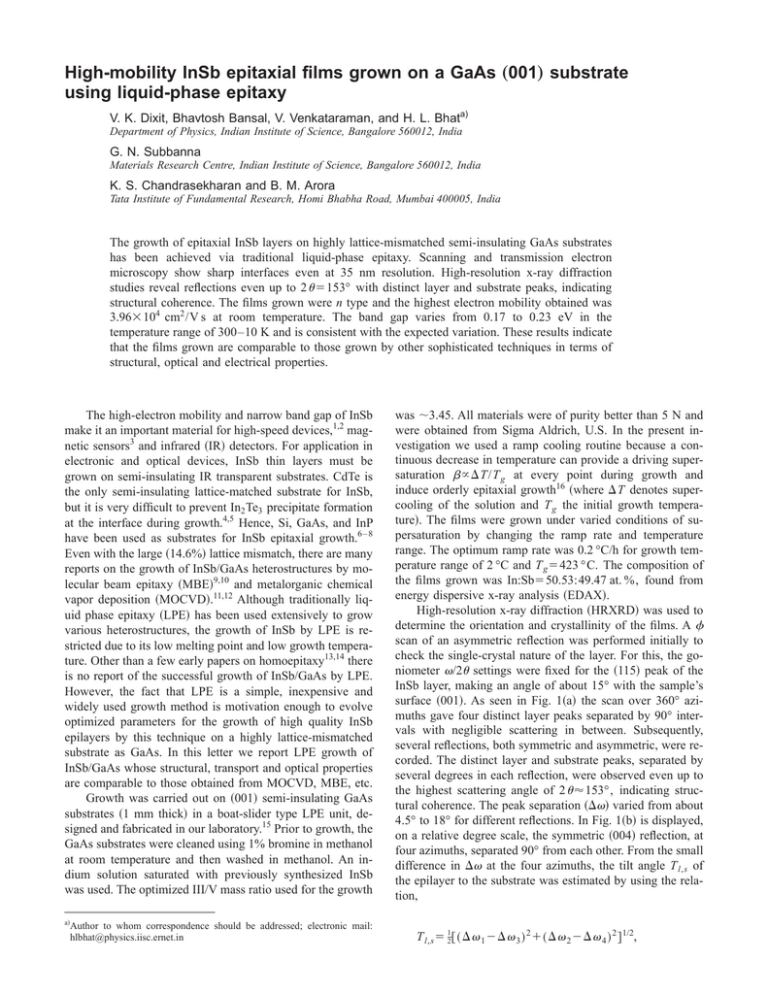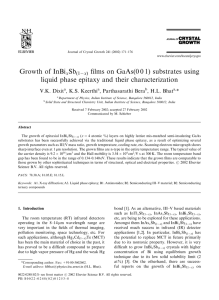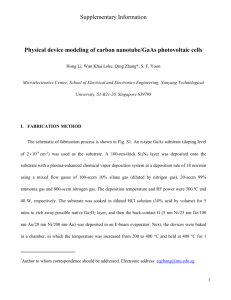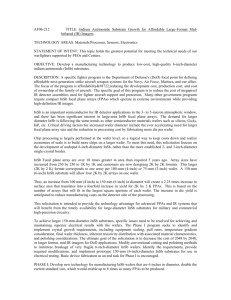High-mobility InSb epitaxial films grown on a GaAs 001 substrate using liquid-phase epitaxy
advertisement

High-mobility InSb epitaxial films grown on a GaAs „001… substrate using liquid-phase epitaxy V. K. Dixit, Bhavtosh Bansal, V. Venkataraman, and H. L. Bhata) Department of Physics, Indian Institute of Science, Bangalore 560012, India G. N. Subbanna Materials Research Centre, Indian Institute of Science, Bangalore 560012, India K. S. Chandrasekharan and B. M. Arora Tata Institute of Fundamental Research, Homi Bhabha Road, Mumbai 400005, India The growth of epitaxial InSb layers on highly lattice-mismatched semi-insulating GaAs substrates has been achieved via traditional liquid-phase epitaxy. Scanning and transmission electron microscopy show sharp interfaces even at 35 nm resolution. High-resolution x-ray diffraction studies reveal reflections even up to 2 ⫽153° with distinct layer and substrate peaks, indicating structural coherence. The films grown were n type and the highest electron mobility obtained was 3.96⫻104 cm2 /V s at room temperature. The band gap varies from 0.17 to 0.23 eV in the temperature range of 300–10 K and is consistent with the expected variation. These results indicate that the films grown are comparable to those grown by other sophisticated techniques in terms of structural, optical and electrical properties. The high-electron mobility and narrow band gap of InSb make it an important material for high-speed devices,1,2 magnetic sensors3 and infrared 共IR兲 detectors. For application in electronic and optical devices, InSb thin layers must be grown on semi-insulating IR transparent substrates. CdTe is the only semi-insulating lattice-matched substrate for InSb, but it is very difficult to prevent In2 Te3 precipitate formation at the interface during growth.4,5 Hence, Si, GaAs, and InP have been used as substrates for InSb epitaxial growth.6 – 8 Even with the large 共14.6%兲 lattice mismatch, there are many reports on the growth of InSb/GaAs heterostructures by molecular beam epitaxy 共MBE兲9,10 and metalorganic chemical vapor deposition 共MOCVD兲.11,12 Although traditionally liquid phase epitaxy 共LPE兲 has been used extensively to grow various heterostructures, the growth of InSb by LPE is restricted due to its low melting point and low growth temperature. Other than a few early papers on homoepitaxy13,14 there is no report of the successful growth of InSb/GaAs by LPE. However, the fact that LPE is a simple, inexpensive and widely used growth method is motivation enough to evolve optimized parameters for the growth of high quality InSb epilayers by this technique on a highly lattice-mismatched substrate as GaAs. In this letter we report LPE growth of InSb/GaAs whose structural, transport and optical properties are comparable to those obtained from MOCVD, MBE, etc. Growth was carried out on 共001兲 semi-insulating GaAs substrates 共1 mm thick兲 in a boat-slider type LPE unit, designed and fabricated in our laboratory.15 Prior to growth, the GaAs substrates were cleaned using 1% bromine in methanol at room temperature and then washed in methanol. An indium solution saturated with previously synthesized InSb was used. The optimized III/V mass ratio used for the growth was ⬃3.45. All materials were of purity better than 5 N and were obtained from Sigma Aldrich, U.S. In the present investigation we used a ramp cooling routine because a continuous decrease in temperature can provide a driving supersaturation  ⬀⌬T/T g at every point during growth and induce orderly epitaxial growth16 共where ⌬T denotes supercooling of the solution and T g the initial growth temperature兲. The films were grown under varied conditions of supersaturation by changing the ramp rate and temperature range. The optimum ramp rate was 0.2 °C/h for growth temperature range of 2 °C and T g ⫽423 °C. The composition of the films grown was In:Sb⫽50.53:49.47 at. %, found from energy dispersive x-ray analysis 共EDAX兲. High-resolution x-ray diffraction 共HRXRD兲 was used to determine the orientation and crystallinity of the films. A scan of an asymmetric reflection was performed initially to check the single-crystal nature of the layer. For this, the goniometer /2 settings were fixed for the 共115兲 peak of the InSb layer, making an angle of about 15° with the sample’s surface 共001兲. As seen in Fig. 1共a兲 the scan over 360° azimuths gave four distinct layer peaks separated by 90° intervals with negligible scattering in between. Subsequently, several reflections, both symmetric and asymmetric, were recorded. The distinct layer and substrate peaks, separated by several degrees in each reflection, were observed even up to the highest scattering angle of 2 ⬇153°, indicating structural coherence. The peak separation 共⌬兲 varied from about 4.5° to 18° for different reflections. In Fig. 1共b兲 is displayed, on a relative degree scale, the symmetric 共004兲 reflection, at four azimuths, separated 90° from each other. From the small difference in ⌬ at the four azimuths, the tilt angle T l,s of the epilayer to the substrate was estimated by using the relation, a兲 Author to whom correspondence should be addressed; electronic mail: hlbhat@physics.iisc.ernet.in T l,s ⫽ 21 关共 ⌬ 1 ⫺⌬ 3 兲 2 ⫹ 共 ⌬ 2 ⫺⌬ 4 兲 2 兴 1/2, FIG. 1. 共a兲 X-ray diffraction pattern of 共 scan兲 the InSb layer in asymmetric reflection 共115兲 over the 360° azimuth and 共b兲 representative scans of the InSb layer/GaAs substrate for 共004兲 reflections at four azimuths 共film thickness 7 m兲. where ⌬ i s are the peak separations at 90° intervals. The tilt was found to be quite small and was about 0.01°. The cross section of the film 共cleaved sample兲 observed under a scanning electron microscope 共SEM兲, shown in Fig. 2共a兲, clearly reflects the sharpness of the interface between the InSb layer and the GaAs substrate. During scanning electron microscopy, simultaneous elemental identification was carried out with 共EDAX兲 to confirm that the region scanned was indeed the InSb/GaAs interface. Cross sectional specimens were prepared and examined at much higher magnification using the JEM-200CX transmission electron microscope 共TEM兲 operating at 200 kV. The bright field cross sectional TEM image, shown in Fig. 2共b兲, indicates a sharp interface with very small coalescing islands 关marked C in Fig. 2共b兲兴. The selected area electron diffraction pattern from the TEM image of an InSb/GaAs interface is shown in Fig. 2共c兲. The diffraction spots occur in pairs, corresponding to InSb and GaAs, respectively, indicating that the layer and the substrate are epitaxially oriented. The temperature dependence of the mobility and carrier concentration in two InSb/GaAs samples, labeled S1 and S2, of thickness 3 and 7 m, respectively, is shown in Fig. 3. The data reported are representative of the five samples studied. The samples were n type in the entire temperature range. FIG. 2. 共a兲 Scanning electron micrograph of the InSb/GaAs interface, 共b兲 bright field image of the cross section of InSb/GaAs and 共c兲 selected area diffraction pattern of 共b兲. The highest room temperature 共RT兲 mobility was measured to be 39 600 cm2/V s, which is comparable to the mobilities reported for InSb/GaAs samples grown by MBE and MOCVD,10,17–20 especially when the purity of the starting material is considered.21 Above 350 K, the samples become intrinsic. At 10 K, the carrier concentration indicates a background doping of around 5⫻1016 cm⫺3 . The purity of the materials used for growth has a strong correlation with the background doping and mobility. Initially, when less than 5 N indium and antimony was used, the carrier density was measured to be more than 1⫻1018 cm⫺3 and the RT mobility less than 8000 cm2/V s. But even for a background doping of 5⫻1016 cm⫺3 , the mobilities around 100 K are still FIG. 3. Temperature dependence of the carrier concentration 共closed symbols兲 and Hall mobility 共open symbols兲. too low, indicating a large number of defects formed due to lattice mismatch at the interface. These are known to limit the mobility.11 There is no observed correlation between the properties of the films with their thickness. Hence there is no prominent interface or surface conduction. Literature on MBE and MOCVD grown films also indicates that more than 2 m from the interface, the films approach bulk InSb in quality.10,12,17,18,22 The Hall data show an anomalous minimum in carrier concentration at some intermediate temperature, which has been observed previously in thin layers and has been attributed to two or three layer parallel conduction.20,21,23,24 However, since the samples are relatively thick 共3–7 m兲 such an interpretation is not possible here. The nature and spatial distribution of dislocations along the growth direction may be a possible cause of the anomaly. Infrared spectra in the wavelength range of 3–25 m at RT and at 80 and 10 K are shown in Fig. 4. The onset of absorption fits very well to the relation ␣ ⬃(E⫺h ) 1/2, indicating a direct energy gap 共inset in Fig. 4兲. The energy gaps were measured to be 0.17, 0.22, and 0.23 eV at RT and at 80 and 10 K, respectively. The values and the temperature de- FIG. 4. Infrared spectra of bulk InSb 共for comparison兲 and InSb/GaAs at different temperatures. The inset shows an 共absorption兲2 vs energy plot at different temperatures 共film thickness 7 m兲. pendence of the energy gap conform to standard results.25 The low temperature energy gap is within the 3.3–5.5 m atmospheric window required for midwave infrared 共MWIR兲 detectors. To conclude, we have shown that InSb films of 3–7 m thickness can be epitaxially grown on lattice-mismatched 共001兲 GaAs substrate by liquid-phase epitaxy. The results indicate that the films are of a high quality and single crystalline with abrupt interface and high mobilities. Hence, LPE can be considered to be an inexpensive and viable alternative for industrial growth of such heterostructures, which are so important for IR detector and magnetic sensor applications. This work was partially supported by a DTSR project and is gratefully acknowledged. The authors thank Vikram Kumar and his team at the Solid State Physics Laboratory, Delhi, for the low temperature IR data. One of the authors 共V.K.D.兲 acknowledges CSIR, India, for awarding him a senior research fellowship. 1 P. G. Kornreich, L. Walsh, J. Flattery, and S. Isa, Solid-State Electron. 29, 421 共1986兲. 2 T. Ashley, A. B. Dean, C. T. Elliott, G. J. Pryce, A. D. Johnson, and H. Willis, Appl. Phys. Lett. 66, 481 共1995兲. 3 J. Heremans, J. Phys. D 26, 1149 共1993兲. 4 K. Sugiyama, J. Cryst. Growth 60, 450 共1982兲. 5 R. Venkataraghavan, K. S. R. K. Rao, M. S. Hegde, and H. L. Bhat, Phys. Status Solidi A 163, 93 共1997兲. 6 B. V. Rao, T. Okamoto, A. Shinmura, D. Gruznev, M. Mori, T. Tambo, and C. Tatsuyama, Appl. Surf. Sci. 159–160, 335 共2000兲. 7 S. D. Parker, R. L. Williams, R. Droopad, R. A. Stradling, K. W. J. Barnham, S. N. Holmes, J. Laverty, C. C. Phillips, E. Skuras, R. Thomas, X. Zhang, A. Staton-Beven, and D. W. Pashley, Semicond. Sci. Technol. 4, 663 共1989兲. 8 M. Mori, Y. Nizawa, Y. Nishi, K. Mae, T. Tambo, and C. Tatsuyama, Appl. Surf. Sci. 159–160, 328 共2000兲. 9 S. V. Ivanov, A. A. Boudza, R. N. Kutt, N. N. Ledentsov, B. Ya Meltser, S. S. Ruvimov, S. V. Shaposhnikov, and P. S. Kop’ev, J. Cryst. Growth 156, 191 共1995兲. 10 P. E. Thompson, J. L. Davis, J. Waterman, R. J. Wagner, D. Gammon, D. K. Gaskill, and R. Stahlbush, J. Appl. Phys. 69, 7166 共1991兲. 11 B. S. Yoo, M. A. McKee, S. G. Kim, and E. H. Lee, Solid State Commun. 88, 447 共1993兲. 12 D. K. Gaskill, G. T. Stauf, and N. Bottka, Appl. Phys. Lett. 58, 1905 共1991兲. 13 M. Kumagawa, A. F. Witt, M. Lichtensteiger, and H. C. Gatos, J. Electrochem. Soc. 120, 583 共1973兲. 14 D. E. Holmes and G. S. Kamath, J. Electron. Mater. 125, 1873 共1978兲. 15 R. Venkataraghavan, N. K. Udayashankar, B. V. Rodrigues, K. S. R. K. Rao, and H. L. Bhat, Bull. Mater. Sci. 22, 133 共1999兲. 16 M. Elwenspoek, J. Cryst. Growth 76, 514 共1986兲. 17 R. M. Biefeld and G. A. Hebner, J. Cryst. Growth 109, 272 共1991兲. 18 E. Michel, J. D. Kim, S. Javadpour, J. Xu, I. Ferguson, and M. Razeghi, Appl. Phys. Lett. 69, 215 共1996兲. 19 J. E. Oh, P. K. Bhattacharya, Y. C. Chen, and S. Tsukamoto, J. Appl. Phys. 66, 3618 共1989兲. 20 J. Heremans, D. L. Partin, D. T. Morelli, C. M. Thrush, G. Karczewski, and J. K. Furdyna, J. Appl. Phys. 74, 1793 共1993兲. 21 E. Michel, H. Mohseni, J. D. Kim, J. Wojkowski, J. Sandven, J. Xu, M. Razeghi, R. Bredthauer, P. Vu, W. Mitchel, and M. Ahoujja, Appl. Phys. Lett. 71, 1071 共1997兲. 22 X. Weng, R. S. Goldman, D. L. Partin, and J. P. Heremans, J. Appl. Phys. 88, 6276 共2000兲. 23 C. Besikci, Y. H. Choi, R. Sudarshan, and M. Razeghi, J. Appl. Phys. 73, 5009 共1993兲. 24 J. R. Soderstrom, M. M. Cumming, J. Y. Yao, and T. G. Andersson, Semicond. Sci. Technol. 7, 337 共1992兲. 25 O. Madelung, Semiconductors—BasicData 共Springer, Berlin, 1996兲.



